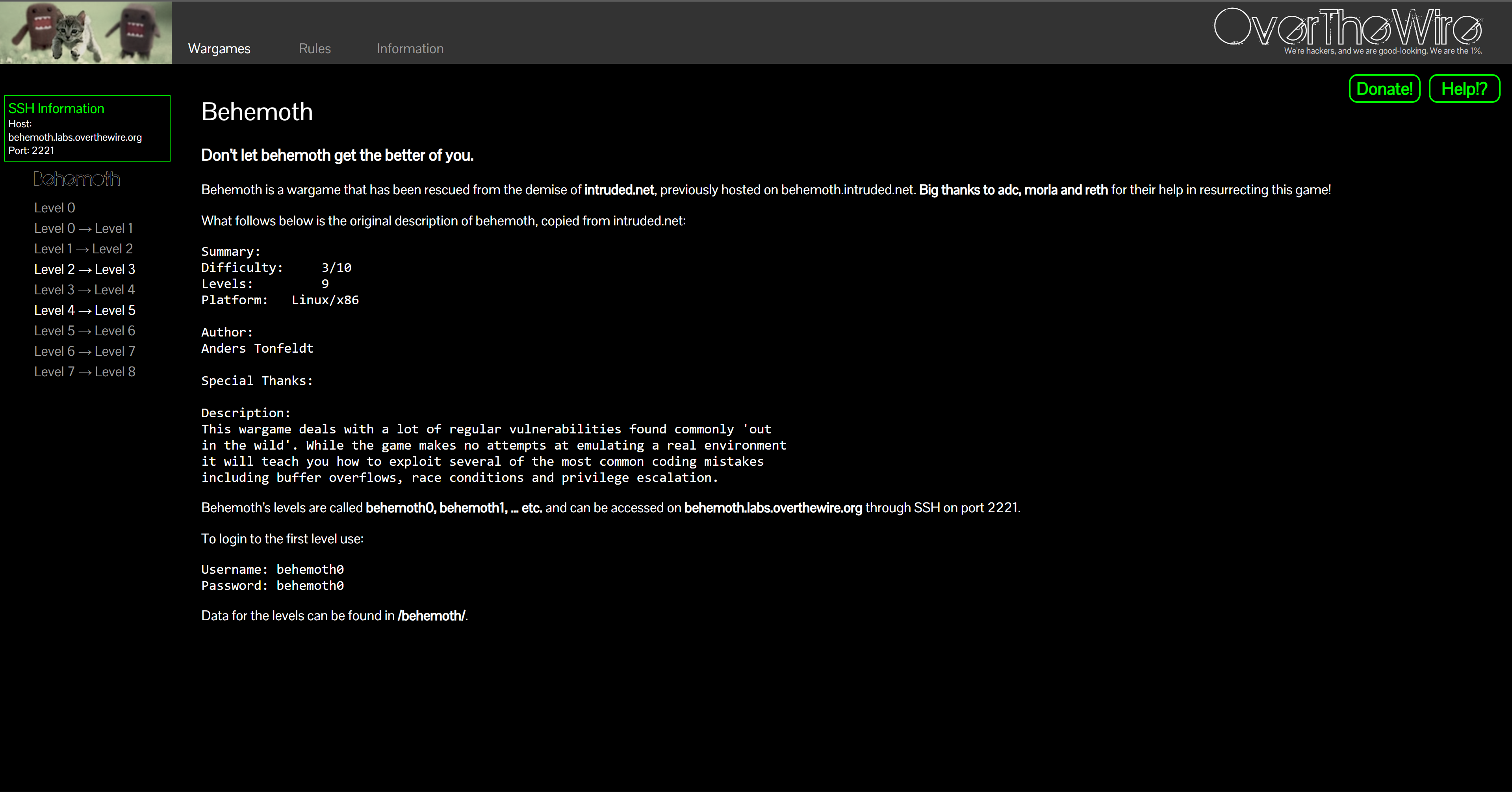OverTheWire Behemoth — Complete Walkthrough Index
OverTheWire Behemoth — Complete Walkthrough Index
Halloo SuiiKawaii dessu!! ✨ Welcome backkk 🔥
After Bandit & Narnia, it’s time to face something even juicier — Behemoth 🗡️🐉.

This post is the master index for my Behemoth walkthroughs. Nothing fancy here — just one place to keep everything organized so you can jump straight into the levels. Strap in, binary exploitation time! 🚀
Introduction
If Bandit was your Linux bootcamp and Narnia your first steps into binaries, then Behemoth is your dojo.
Here you’ll wrestle with setuid programs, buffer overflows, format strings, and privilege escalation tricks. It’s hands-on, unforgiving at times, but super rewarding.

Why play Behemoth?
- Teaches real binary exploitation fundamentals in a safe lab.
- Improves your C & memory model intuition.
- Builds mindset for reverse engineering & exploit dev.
- Totally free — all you need is an SSH client.
By the end you’ll be confident in:
- Inspecting binaries with
strings,ltrace,strace,objdump,gdb. - Recognizing memory corruption & logic flaws.
- Crafting small exploits to grab higher-privilege shells.
- Reading C code like an attacker 👀.
About This Series
Each Behemoth level post includes:
- Login Info — how to SSH into that level.
- Task — the official OTW description.
- Theory — short notes on the binary exploitation concept involved.
- Solution — step-by-step walkthrough (commands, code, output).
⚠️ Goal: not to spoon-feed passwords, but to show why each step works — so you can apply the same tricks elsewhere.
How to Play Behemoth
- Read the challenge carefully.
- Experiment — run the binary with different inputs.
- Use debugging tools (
ltrace,strace,gdb, etc.). - Take notes of weird outputs, crashes, unexpected behavior.
- Fail, retry, learn, repeat — until you win 🏆.
💡 Pro tip: when in doubt, throw your input at the program until it breaks. That’s often where the fun begins 😉
Levels Index (0 → 8)
Each link opens in a new tab. The short tagline hints at the key idea.
-
🐣 Level 0 — SSH Login
Read post → — First login, just warm-up. -
🧵 Level 0 → 1 — Buffer Overflow Intro
Read post → — A tiny stack smash to pop a shell. -
🔍 Level 1 → 2 — Input Validation Flaw
Read post → — Beat the program’s bad logic with crafted input. -
🪄 Level 2 → 3 — Format String Basics
Read post → — Use%xmagic to leak secrets from memory. -
🔑 Level 3 → 4 — Privilege Escalation Binary
Read post → — Abuse setuid misconfigs to climb higher. -
⚡ Level 4 → 5 — Environment Variable Attack
Read post → — Exploit unsafegetenv()handling. -
💉 Level 5 → 6 — Buffer Overflow (Deeper)
Read post → — Push the stack harder, gain control. -
🕵️ Level 6 → 7 — File Descriptor Trick
Read post → — Redirect FDs to bypass security checks. -
🏁 Level 7 → 8 — Final Exploit!
Read post → — Put it all together for the final win 🎓
Conclusion
Clearing Behemoth takes you from “Linux adventurer” → “binary hacker apprentice” 🐉.
You’ll touch the pillars of exploitation:
- Memory corruption.
- Format strings.
- Privilege escalation.
And the best part — you’ve done it all legally in a fun lab 🎮.
Next adventures:
Keep hacking, keep learning, keep breaking (responsibly) 📝💥
Thanks for reading!
Until next time — Otsumachi!! 💖☄️✨


